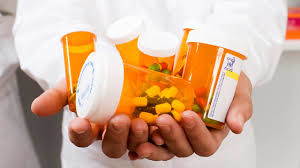Blog
Opioid pain medication INCREASES pain
Tags: natural pain relief, pain management, pain relief, pain treatment, physical therapist Prescott, physical therapists Prescott, Prescott physical therapy

The entire point of pain medication is obviously to eliminate or reduce pain to a tolerable level. Unfortunately, opioid pain medication has the potential to do exactly the opposite. Opioid pain medications such as oxycodone and hydrocodone are very commonly prescribed to patients with low back pain or any musculoskeletal pain in general. The threat of addiction and overdose when using opioids has been discussed here. What has not been discussed and what the majority of patients and even healthcare providers are unaware of is how opiates and other pain medication increases pain levels (1-3).
This sounds far-fetched, right? How could a drug designed to reduce pain make pain worse? With a general understanding of neurophysiology, it’s pretty straightforward. Your brain produces neurotransmitters called endorphins, which are essentially morphine. So your brain makes its own morphine or pain relieving chemicals. Your body always wants to be in a balanced state so when you take in artificial morphine (pain medications), your brain quits making its own pain killers (endorphins). Now your body craves or needs the pain medication because it needs to have a maintenance level of morphine in the system, and since you’re no longer making your own, you have to get the chemical in your system by taking the drug.
While this happens, the opioid pain medication does reduce pain, initially. The chemical in the pain medication binds to receptors in the brain and blunts the perception of pain. The drugs do work, at first. Pain happens to be a survival mechanism, though. And because it’s a survival mechanism, when it’s dampened, your body rebels. The central nervous system (brain and spinal cord) responds to the excessive opioids in the system by ramping up the pain system. In short, this is akin to turning up the volume on a stereo. The nervous system becomes more sensitive to pain and stimuli in an effort to offset the blunting of the pain response by the medication. Since the pain system is now more sensitive and ramped up, more pain medication is required to blunt the perception of pain. This cycle goes on until a maintenance dose of opioid pain medication is required for the patient to feel “normal,” even though “normal” is still painful.
How long does this take? Brain changes are induced within one month of being on opioids such as morphine. One month! These changes do NOT reverse within five months of being off morphine. The region of the brain that perceives and deals with pain changes; it becomes more sensitive and turned up. Physicians and pain scientists refer to this as hyperalgesia, which simply means increased sensitivity to pain. Opioid use also negatively affects areas of the brain associated with attention and learning (4). So not only do these drugs cause people to feel more pain over time, they negatively affect your ability to learn and pay attention!
In people with chronic pain, simply detoxing from these drugs for five days has been shown to reduce pain levels substantially. Make certain you understand this statement. Stopping the daily intake of opiate pain medication REDUCES pain! This has been shown clinically in medical journals (5). Those who have chronic pain and have been on these drugs for years can reduce their pain by getting OFF the drugs used to purportedly treat the pain.
Bottom line: If you have chronic pain and have been taking opiates for pain management over the course of months or years, you need to take an objective look at getting off these drugs. If the thought of doing this makes you uncomfortable, you’re already dependent on the substance. I hear this all the time from people with chronic pain conditions. “I ran out of my oxycodone, so I’m in a lot of pain. I must have my oxycodone to be normal.” It’s difficult to explain to these individuals that their beloved pain medication is likely making their pain worse and that quitting it will actually REDUCE their pain. But this is the truth. The scary part is the majority of people in this boat are completely unable to quit taking the medication. They literally have to go to a detox facility to get off it. It’s well worth the hassle, though; these people on average realize a 2-3 point decrease in pain levels in just five days when getting off these drugs!
If you suffer from chronic pain and take opioid pain medications, talk to your physician about getting off these drugs to REDUCE your pain. If you injure your low back or any other body part and are prescribed these medications, use them as they’re meant to be used for musculoskeletal pain, acutely, not for months and years.
1. White, J. (2004). Pleasure into pain: the consequences of long-term opioid use. Addictive Behaviors , 29(7), 1311-24.
2. Hay, J., White , J., Bochner, F., Somogyi, A., Somogyi, A., Semple , T., & Rounsefell, B. (2009). Hyperalgesia in opioid-managed chronic pain and opioid-dependent patients. The Journal of Pain , 10(3), 316-22.
3. Ren, Z., Shi, J., Epstein, G., Wang, J., & Lu, L. (2009). Abnormal pain response in pain-sensitive opiate addicts after prolonged abstinence predicts increased drug craving. Psychopharmacology, 204(3), 423-9.
4. Younger, J., Chu, L., D, N., Trott, K., Jastrzab, L., & Mackey, S. (n.d.). Prescription opioid analgesics rapidly change the human brain. Pain, 152(8), 1803-10.
Rosenblum, A., Josheph , H., Fong , C., Kipnis , S., Cleland , C., & Portenoy, R. (2003). Prevalence and characteristics of chronic pain among chemically dependent patients in methadone maintenance and residential treatment facilities. JAMA, 289(18), 2370-8.
5. Miller, N., Swiney , T., & Barkin, R. (2006). Effects of opioid prescription medication dependence and detoxification on pain perceptions and self-reports.American journal of therapeutics , 13(5), 436-44.